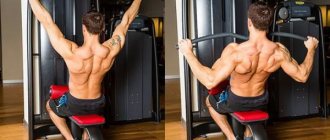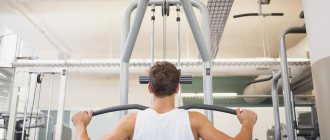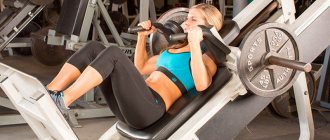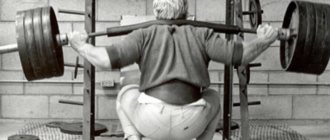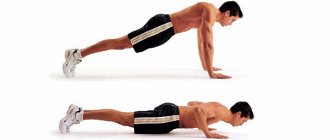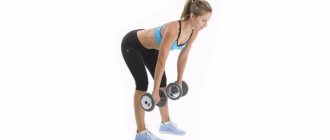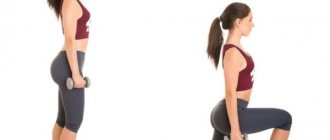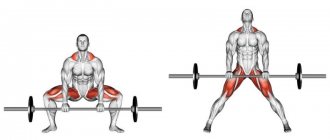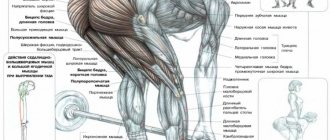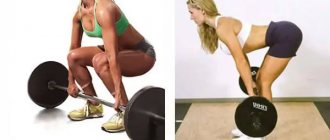Upper block pull
Actually, what is good about the pull of the upper block is that it is “creative”, i.e. variable exercise. The most common are the following rod options:
- Per head;
- in front of the chest;
The purpose of the lat pulldown is to work the back muscles . In essence, these are the same pull-ups on a bar, only in reverse: in this exercise, it is not you who are pulled up, but the bar (the handle of the exercise machine) “seeks” towards you. The lat pulldown would be a great addition to the deadlift .
If you still think that doing basic exercises is unfeminine or you want to, but are afraid, then the article “Do the basics, beauty, or everything about the squat, deadlift and press for the fair sex” is for you!
What muscles are involved?
The lat pulldown has as its main goal working the latissimus dorsi muscles , which are also called the wings. Secondary muscles are the biceps, shoulders and forearms. The long head of the triceps acts as a dynamic stabilizer.
A complete list of muscles involved in the movement and engaged by this exercise:
- brachialis/brachioradialis;
- biceps;
- large/small round;
- rear delta;
- cavity;
- diamond-shaped;
- levator scapula;
- trapezoidal (lower/middle parts);
- small pectoralis.
The head pull is a basic exercise, as it involves the work of several muscle groups and joints. Despite this, it is recommended to use it as an additional load after performing heavy exercises, usually, as already mentioned, after deadlifts.
IMPORTANT: When performed regularly and correctly combined with other exercises, lat pulldowns both behind the head and to the chest help strengthen muscles and get rid of chronic pain in the shoulders and lower back. However, if you know that you have back problems, you should not exercise without the permission of a (preferably sports) doctor.
How to take the right selfie or how to become a fit girl in 5 seconds?
Inclusion in the training program
Thanks to its technical ease, the vertical overhead pull-down is suitable for everyone - from beginners to professional bodybuilders.
For most beginners, this is one of the main (if not the main) exercises for pumping up the back muscles.
As a rule, beginners put it first or second in their training program. In this case, light and medium weights are used, in the repetition range - 10-15 times per approach.
The main goal during this period is not lifting kilograms, but learning the correct movement technique. And also the development of the connection between the brain and muscles, which helps to feel and constantly control the lats.
For intermediate and advanced levels, the exercise is used more variably.
When training for mass, it can be the first in the program, used as a warm-up (light weight and 10-15 repetitions per approach). Or maybe the first, heavy movement on the back (medium weight and 8-12 repetitions).
The deadlift is also placed in the middle or at the end of the complex, using it as a finishing movement . In this case, a pump load mode is used - light weight and 12-15 repetitions per set, with minimal rest - up to a minute.
The upper block behind the head is often used when training for relief and detailing of the back muscles. Here they use light weight and the same 12-15 repetitions per approach, but the tempo of movement changes to 2-2-2. That is, the phase of maximum contraction of the back muscles increases to two seconds.
What is the difference between behind the head and towards the chest?
Despite common misconception, the neck pulldown does not engage the lats better than the classic chest pulldown, but the former does pose an increased risk for shoulder injury. Muscle activity in these two options is almost the same, which cannot be said about the load on the shoulder joints and rotator cuff.
According to a study published in the Journal of Strength and Functional Training, when the shoulder joints are placed in a position of horizontal abduction in combination with external rotation (as we see with a lat pulldown), stress on the rotator cuff increases.
To stabilize the humeral head, the rotator cuff muscles have to work harder, leaving them vulnerable and increasing the risk of injury, particularly tendinitis and pain. In short, you can injure your shoulder.
Particularly zealous individuals, when zealously performing head pulls in the lower phase of the movement, can hit themselves with a bar on the cervical vertebrae, which can result in bruising and even fracture.
Bottom line: By performing chest rows, you not only get similar or better muscle activity, but you also reduce the risk of shoulder, neck, or nerve damage, so it's best not to take any chances. Although, again, with the correct technique and high-quality, thoughtful execution, you are unlikely to harm yourself.
Harmful exercises in the gym: never do them!
Execution technique
The overhead pull-down is an exercise whose technique requires skill that is developed with light weight. The correct technique allows you to work exactly those muscle groups for which the exercise is intended.
If there are errors in technique, other muscle groups are involved in lifting the weight, which reduces the load on the target muscle and reduces the effectiveness of training. The main “chips” of execution:
- Sit facing the machine, fix your hips under the bolsters. Adjust the desired height.
- The angle between the shin and thigh should be 90°, with the feet flat on the floor.
- The back is straight in a natural position with a deflection in the lower back, the gaze is directed forward.
- Take the bar of the upper block with both hands with a wide grip - grab it as wide as possible.
- As you inhale, carefully and smoothly pull the bar behind your neck to the level of the back of your head (ear level).
- Try to bring your elbows closer to your body, bringing your shoulder blades together. Pull with your shoulder blades together, not with your hands.
- At the same pace, return your hands to their original position and exhale. Feel the muscle stretch at the top.
If you are working out with a coach or friend, he can help you push the handle and pick it up at the end of the exercise (at the top point). If you are working out with a lot of weight, you can ask someone to help you pick up the block at the end.
Start with 4 sets of 12 reps. Use a lighter weight to practice your technique. When training for mass, do 4 sets of 10-12 repetitions, increasing the weight with each approach. When cutting - 4-5 sets of 15-20 repetitions with a lower initial weight, increasing the weight or number of repetitions with each approach.
Lat rows or pull-ups?
Which exercise is better for the back: pull-ups or overhead rows? So, of course, pull-ups are better for back width, this is as obvious as the superiority of working with free weights over machines, but not every beginner can master at least 5 pull-ups. You understand that the amount of work that needs to be done to see the result is clearly greater.
So an excellent way out in this situation is to perform lat pull-downs , and then gradually switch to pull-ups on the horizontal bar. In this way, we develop the strength needed to pull our body up on the treasured horizontal bar. As an intermediate option (especially for girls), you can use pull-ups in a gravitron , and as strength develops, switch to a pull-up .
Pull-ups on the bar with rubber shock absorbers
A general tip when working with a lat pulldown machine is to include free weights in your training program.
Correct exercise mechanics
Mechanics of performing the upper row: as you exhale, begin to slowly pull the bar down towards your chest, trying to engage the latissimus dorsi muscles and open your chest even more. Make sure that your shoulder blades are constantly brought together and maintain a stationary position of your back, without leaning back or increasing the arch in your lower back.
Pause for a few seconds at the bottom point of the trajectory (the bar is at a distance of 3-5 centimeters from the chest, but does not touch it), feeling the tension in the latissimus muscles. Elbows point slightly back. Then slowly return the bar to the starting position - being careful to resist the force of inertia and maintain control of the weight at all times.
Top link: common mistakes
The most common mistake when performing seated lat pull-downs is using too much weight in the exercise. Essentially, this makes it impossible to control technique (and especially keeping the shoulder blades pulled together), and also shifts the load from the latissimus dorsi to the shoulders, arms and other secondary muscle groups.
In addition, remember that the body must be strictly fixed when performing the exercise - you should not lean back or arch your whole body to pull the weight to your chest. You should also constantly control the weight and not try to use the force of inertia when pulling - you need to slowly lower the bar down, and not pull it with all your might.
Technique to the chest
- Go to the machine and install the straight handle. Sit on the bench and place your knees under the bolsters , having previously adjusted their height. This is necessary so that the working weight does not pull you up. Set the optimal height of the thrust rollers for the legs of the block exercise machine in the vertical row: they should firmly fix the hips, preventing them from coming off the bench during the exercise, otherwise you simply will not be able to do the exercise normally .
- Before pulling the block to your chest, lean back slightly so that the angle is 70-80 degrees, bending your chest forward and arching your lower back. Grab the handle with an overhand grip. Stretch your arms up, holding the bar at the selected width. Remember, the narrower the the biceps work (which we don’t need) and the greater the range of motion . The wider the grip, the more the back (which is what we are trying to achieve), but the amplitude .
So you yourself will have to look for “your” optimal grip, in which you will have a greater range of motion , and the biceps will not take the entire load . Choose a grip that suits you, i.e. According to my feelings, I follow the rules outlined above. - In this case, the pelvis must be placed on the seat so that the upper block and bar are not in front of the chest (as many recommend), but DIRECTLY ABOVE YOU (above your head). This is done specifically so that the back muscles contract. Elbows should be pulled back .
- Inhale, and as you exhale, begin to pull the bar down until it touches your upper chest. You need to pull strictly vertical (without bending towards yourself), i.e. the handle must go up down. To do this and in order not to hit your head on the handle, you need to do arch in the lower back(push your chest forward). Thanks to the deflection in the lower back, you seem to lean back, and it is due to this that the handle will pass past your head (your face, chin and neck, by the way, face looking up) descending to the upper chest.
It turns out that in this position and only in it, we pull the handle VERTICALLY DOWN. In another position, we pull it AT AN ANGLE (toward us), which absolutely negates all efforts.
Improper execution of the exercise. The cable does not go vertically, but at an angle!
Make sure that your upper body remains motionless and only your arms should move. At the lowest point (compressed position), additionally squeeze your shoulder blades. Do not pull the bar with your hands; they are simply needed to hold the projectile.
- The movement should occur calmly, smoothly, without jerking . At the bottom point, hold for 1-2 counts and statically squeeze your back muscles, then slowly return to the starting position (at the top point, DO NOT EXTENSH YOUR ELBOWS TO THE END, so that the load does not leave the back muscles).
- Slowly and under control, return the bar up, but your arms should not be completely straight and your latissimus dorsi muscles should be stretched. Inhale during this part of the movement.
Tip : When performing rows and pull-ups, never extend your arms completely . When you straighten your arms, the muscles become severely stretched, which can lead to tears in your biceps and shoulder muscles. It is better to maintain constant muscle tension to avoid injury, God protects the best. Some people straighten their arms to rest between reps. If you choose this option, keep in mind that hanging from a bar puts your shoulder ligaments in a vulnerable position . Try to perform rows and pull-ups in one smooth motion, without jerking.
Fructose: is it possible to eat fruit and lose weight?
Mistakes and how to deal with them
MAIN MISTAKE #1: the movement comes from the arms, not from the back.
WHY IT ARISES: Every chain is only as strong as its weakest link.
This is a great analogy for many back exercises because they involve the biceps. The problem is that our biceps are smaller and weaker than our backs, and accordingly they get tired earlier. You will have to figure out how to pull the weight with your back and not your biceps, otherwise your back workout will end much earlier than necessary.
The rule for these (and many other) exercises is that if you feel that the exercise is not working the same muscle as intended, then something is wrong, you need to reconsider your views on the technique.
SOLUTION : Part of the solution to the problem is to distribute the effort correctly. It is necessary that the movement begins with the back muscles, moving the shoulders. At the same time, the arms are bent at the elbows only to allow the shoulder to move with maximum amplitude. Imagine that your hands are just ropes with which you cling to the handle, and your motor, locomotive, driving force is your back. Do it smoothly. There is no need to split the work of the back into separate phases.
Still not feeling the targeted muscles in the exercises? Then read: “Concentration on the desired muscle or shake your butt with your head”
MISTAKE #2: lowering the pulley handle too low.
WHY IT ARISES: It doesn’t matter at all why you are torturing yourself so much, trying to reach the handle of the block to your feet. After all, it's none of our business. The important thing is that you are trying to work with a weight that you cannot control, thereby reducing the effectiveness of the exercise. Below the level of the upper chest, the triceps comes into play, which no longer pulls, but pushes (without the help of the back!) the handle further, towards the hips.
HOW TO FIX: Don't pull low, that's all
